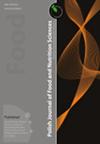包装对食用花卉冷藏期间微生物品质的影响
IF 2.3
4区 农林科学
Q3 FOOD SCIENCE & TECHNOLOGY
引用次数: 1
摘要
食用花是指通常未经热处理就新鲜食用的食品。由于它们的化学成分和低加工程度,它们可以成为微生物的良好繁殖地,从而成为感染源。它们的保存方法包括适当的包装和低温储存。因此,本研究的目的是评估包装类型(真空密封聚酰胺/聚乙烯袋和聚对苯二甲酸乙二醇酯盒)对冷藏期间包括旱金莲、金盏花和雏菊在内的可食用花卉的微生物污染的影响。测定收获当天和冷藏1-3天后所选致病菌、总酵母和霉菌的计数。结果表明,可食用的花朵不含沙门氏菌或大肠杆菌(旱金莲除外),而所有花朵均含有酵母和霉菌,数量约为4–5 log cfu/g,金黄色葡萄球菌数量为1.89至2.72 log cfu/g。霉菌和金黄色葡萄球菌计数的差异在统计学上是显著的,这取决于花的类型。包装类型和冷藏条件下的储存时间都不影响花朵的微生物污染程度。本文章由计算机程序翻译,如有差异,请以英文原文为准。
Effect of Packaging on Microbial Quality of Edible Flowers During Refrigerated Storage
Edible flowers are food products that are usually eaten fresh without prior heat treatment. Due to their chemical composition and low degree of processing, they can be an excellent breeding ground for microorganisms, and thus a source of infection. Methods of their preservation include proper packaging and storage at low temperatures. Therefore the aim of this study was to evaluate the effect of type of packaging (vacuum-sealed polyamide/polyethylene bag and polyethylene terephthalate box) on the microbial contamination of edible flowers including nasturtium, calendula, and daisy during refrigerated storage. The counts of selected pathogenic bacteria, total yeasts and moulds on the day of harvesting and after 1–3 days of refrigerated storage were determined. The results showed that the edible flowers did not contain Salmonella sp. or Escherichia coli (except nasturtiums), while all flowers contained both yeast and moulds at counts about 4–5 log cfu/g, and Staphylococcus aureus at numbers ranging from 1.89 to 2.72 log cfu/g. The differences in the counts of moulds and S. aureus were statistically significant depending on the type of flower. Neither the type of packaging nor storage time under refrigerated conditions influenced the degree of microbial contamination of the flowers.
求助全文
通过发布文献求助,成功后即可免费获取论文全文。
去求助
来源期刊

Polish Journal of Food and Nutrition Sciences
FOOD SCIENCE & TECHNOLOGY-
CiteScore
4.30
自引率
12.50%
发文量
25
审稿时长
20 weeks
期刊介绍:
The Polish Journal of Food and Nutrition Sciences publishes original, basic and applied papers, reviews and short communications on fundamental and applied food research in the following Sections:
-Food Technology:
Innovative technology of food development including biotechnological and microbiological aspects
Effects of processing on food composition and nutritional value
-Food Chemistry:
Bioactive constituents of foods
Chemistry relating to major and minor components of food
Analytical methods
-Food Quality and Functionality:
Sensory methodologies
Functional properties of food
Food physics
Quality, storage and safety of food
-Nutritional Research Section:
Nutritional studies relating to major and minor components of food (excluding works related to questionnaire
surveys)
-“News” section:
Announcements of congresses
Miscellanea
 求助内容:
求助内容: 应助结果提醒方式:
应助结果提醒方式:


